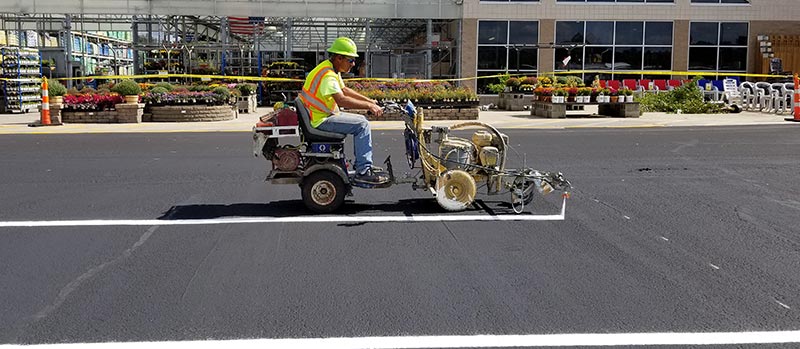Top Guidelines Of A1 Professional Asphalt & Sealing Llc
Top Guidelines Of A1 Professional Asphalt & Sealing Llc
Blog Article
The Basic Principles Of A1 Professional Asphalt & Sealing Llc
Table of ContentsSome Ideas on A1 Professional Asphalt & Sealing Llc You Should KnowThe Basic Principles Of A1 Professional Asphalt & Sealing Llc The Best Strategy To Use For A1 Professional Asphalt & Sealing LlcA1 Professional Asphalt & Sealing Llc Fundamentals ExplainedThe Best Strategy To Use For A1 Professional Asphalt & Sealing Llc
In its make-up, asphalt is composed mostly of Bitumen incorporated with different kinds of accumulation, such as sand or crushed rock. Pavement, conversely, is a kind of concrete which contains accumulations, cement, and water. a1 asphalt. Depending on the area and usage of the utilized sidewalk material, a mix of different chemical admixtures may be contributed to make it much more resilient
What is the difference between asphalt and blacktop driveways? Blacktop is a mix of rock, sand, and crushed rock covered with asphalt. Blacktop is created to develop an even surface due to its boosted resistance to weathering and ability to bear heavier tons. What is the difference in between asphalt concrete pavement and concrete? Pavement can be constructed from either asphalt or concrete, with asphalt being smoother and much more resistant due to its binder, while concrete hardens through the treating process but has a tendency to put on down over time due to weathering.
Fascination About A1 Professional Asphalt & Sealing Llc
Just how do I preserve my asphalt driveway? The most crucial part of preserving an asphalt driveway is making sure it's appropriately secured.
These ought to be gotten rid of and filled up out as quickly as feasible. Consistently sweep away any kind of loose rocks, dirt, or foliage to avoid more damages from occurring. Asphalt and sidewalk are basic fixtures on roadways all over. Despite their resemblances, these two materials have some crucial differences that make each suitable for various scenarios.
Comprehending these differences can help guarantee an appropriate decision is made when selecting a surface remedy. You can learn more articles similar to this one here.
Not known Facts About A1 Professional Asphalt & Sealing Llc
Just recently, State highway agencies and FHWA were astonished by a discovery: The private use of re-refined engine oil bases in asphalt prevails. Simon Hesp, Queens University (Kingston, Ontario) Asphalt is the sticky black deposit that is left over from the handling of petroleum. It has actually been made use of in paving for more than a a century.

The asphalt, which serves as the sidewalk's binder, is also the most costly part of the expense of the material for paving roads. The weight of an asphalt sidewalk varies depending upon the aggregate kind, the asphalt, and the air space web content. Using an average instance of 112 extra pounds per square yard per inch of thickness, a 1-mile (1.6-kilometer)-long, four-lane freeway with a 4-inch (10-centimeter) lift and 12-foot (3.6-meter)-vast lanes evaluates concerning 6,300 heaps (5,700 metric tons).
The 300 bunches of asphalt in 2002 would have cost around $48,000. The climbing price of asphalt had a significant influence on the cost of constructing sidewalks, which boosted passion in discovering ways to lower costs.
Rumored Buzz on A1 Professional Asphalt & Sealing Llc
RAP already consists of asphalt, albeit aged material that does not have the very same properties of fresh asphalt. During a hallway discussion at a 2010 technological meeting, Matt Mueller, then a State engineer of materials from Illinois, disclosed that his division of transportation had actually found phosphorous in among the asphalt binders it was acquiring.

The vendor refuted including PPA, yet declined to reveal what had been contributed to the binder. When pushed by the department of transport, the vendor disclosed that it was adding what it called an asphalt extendernow understood to be re-refined engine oil bases (REOB). REOB consists of a percentage of phosphorus, which is what division drug stores originally determined.
"No one recognized this product was being added to asphalt, had actually seen any kind of research on how this might impact performance of hot-mix asphalt sidewalks, or knew for how lengthy and exactly how extensively it was being made use of throughout the country," claims Mueller. After discussions at the technological conference, he says, "It swiftly went from being just a problem in Illinois to coming to be a nationwide and worldwide concern." Component of the objective of the Chemistry Laboratory at TFHRC is to develop new test approaches.
The buildings of asphalt binders differ extensively depending on the resource of the crude oil and the refining procedure used. For low winter temperatures, softer asphalts are essential to prevent breaking.
The Basic Principles Of A1 Professional Asphalt & Sealing Llc
A machine called a vibrant shear rheometer (DSR) was presented to the market during the Strategic Highway Study Program's research study project, which ran from 1987 to 1992. The DSR is currently the sector standard for determining the viscoelastic properties of paving asphalt. The device was not created for the paving sector (https://www.twitch.tv/a1asphaltseal/about).
For example, the DSR enables product programmers to develop tooth paste with the best consistency so that it can be squeezed from a tube but not fall off the tooth brush. The DSR tests binder put in between 2 parallel plates about the size of a quarter. One of the plates moves and the device gauges the viscoelastic buildings of the asphalt.
Report this page